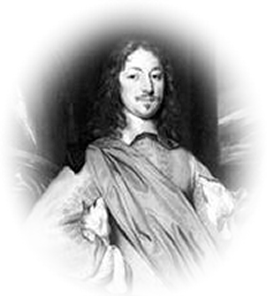Montague Bertie, 14th Baron Willoughby d’Eresby, 2nd Earl of Lindsey was born around 1608 and died on 25th July 1666 at Campden House, Kensington.
He was the eldest son of Robert Bertie who had been Lord High Admiral of England, Lord Lieutenant of Lincolnshire and a Knight of the Garter. He was granted access as a fellow-commoner at Sidney Sussex College, Cambridge on 1st February 1623 where he studied briefly. In 1624 he was returned as Member of Parliament for Lincolnshire and returned as member for Stamford during 1625-6. In his early years he served as a Captain of Cavalry in the Low Countries. Charles I appointed him as a Gentleman of the Privy Chamber and Warden of Waltham Forest in 1634. His first wife, Martha, who he married on 18th April 1627 was daughter of Sir William Cockayne and widow of John Ramsay , Earl of Holdernesse.
During the Bishops War of 1639 he raised four companies of Lifeguards for the Kings campaign against the Scottish Covenanters. In 1642, as civil war became more inevitable he, with his father, obeyed the Kings Commission of Array and raised troops from Lincolnshire for Royal service. At the battle of Edgehill on 23rdOctober 1642, in command of the Lifeguard, he made a desperate attempt to rescue his mortally wounded father and failing in this he voluntarily delivered himself up so that he might attend him.
He remained a prisoner in Warwick Castle until July 1643 eventually obtaining an exchange whereupon he went to Oxford where he was made welcome by the King. During his imprisonment he wrote a Declaration and Justification in which he pledged his loyalty to the King “upon whose head this crown is by the law of nature and nations justly fallen”. On his release he was made a Privy Councillor and made Lieutenant-General of the King’s regiment of foot lifeguards. He fought at the battles of Newbury, Cropredy Bridge and Lostwithiel and along with Lord Ashley commanded the right hand reserve at Naseby, where he was wounded.
Alongside of his military activities he was regularly involved as one of the King’s commissioners in successive peace treaties and was one of several moderate Royalist Peers who constantly urged the King to reach an accommodation with Parliament. Lindsey was summoned by the King to attend him during the summer and autumn of 1647 and was appointed one of the commissioners at the treaty of Newport between September and December 1648. He attended the King during his trial and was one of four peers to accompany the King’s body to Windsor Castle after the execution.
Lindsey paid a high price for his Royalist allegiance, his estates having been sequestered in May 1643 and in December 1646 he compounded in accordance with the Oxford articles at the rate of one tenth or two years income. His composition fine was set at £4360 (subsequently reduced to £2100) which was not paid of until the summer of 1651.
Lindsey retired to his estate and for a while was watched by the council of state during the early 1650’s but there was no evidence that he was involved in any uprising or rebellion during that time. At some point between 1646 and 1653 he married Bridget, daughter of Edward Wray groom of the bedchamber to Charles I and widow of Edward Sackville, who died in 1657.
After the return of Charles II he was again appointed a privy councillor and was admitted to his fathers old office as Lord Great Chamberlain in which capacity he officiated at the Kings coronation on 23rd April 1661. He was one of the judges at the trial of the regicides and was appointed Lord Lieutenant of Lincolnshire and made a Knight of the Garter in 1661.
He is buried in the family vault, with his father, at Edenham, Lincolnshire.
